Abstract
AZ31 magnesium alloy sheets were prepared by low-speed extrusion at different temperatures, i.e., 350 °C, 400 °C, and 450 °C. The microstructure evolution and mechanical properties of extruded AZ31 magnesium alloy sheets were studied. Results indicate that the low-speed extrusion obviously improved the microstructure of magnesium alloys. As the extrusion temperature decreased, the grain size for the produced AZ31 magnesium alloy sheets decreased, and the (0001) basal texture intensity of the extruded sheets increased. The yield strength and tensile strength of the extruded sheets greatly increased as the extrusion temperature decreased. The AZ31 magnesium alloy sheet prepared by low-speed extrusion at 350 °C exhibited the finest grain size and the best mechanical properties. The average grain size, yield strength, tensile strength, and elongation of the extruded sheet prepared by low-speed extrusion at 350 °C were ~2.7 μm, ~226 MPa, ~353 MPa, and ~16.7%, respectively. These properties indicate the excellent mechanical properties of the extruded sheets prepared by low-speed extrusion. The grain refinement effect and mechanical properties of the extruded sheets produced in this work were obviously superior to those of magnesium alloys prepared using traditional extrusion or rolling methods reported in other related studies.
1. Introduction
At present, magnesium alloy products have been used in almost every aspect of human life. For example, magnesium alloys can be used to produce light-weight automobile components or to satisfy the noise-absorbing, shock-absorbing, and radiation-resistance requirements in the aerospace industry [1,2]. Magnesium alloys can also be used to build lighter weapons and equipment for military use, which will enhance maneuverable tactical performance and performances in remote and precision strikes. Further, magnesium alloys have also been used widely in electrical and information industries due to their advantages, e.g., the high specific strength, good thermal and electrical conductivity, environmental friendliness, and excellent electromagnetic shielding performance, and because they meet the requirements for light, thin, and small-footprint 3C products [2]. Therefore, accelerated research and development of magnesium alloy materials will have a profound impact on the promotion of societal development and human life improvement.
Currently, the majority of magnesium alloy products are castings, especially die-castings [2,3]. However, the microstructures of such products are not ideal and the mechanical properties are poor, which has greatly hindered the wider applications of magnesium alloys. The deformed magnesium alloys prepared by plastic processing typically exhibit higher strength and toughness, and can thus meet the requirements of a good deal of structural components [4,5]. Forward extrusion is a widely used plastic processing method in the production of wrought magnesium alloys. During the extrusion, the material will be subjected to high hydrostatic pressure, and a large amount of deformation will occur, which is beneficial for eliminating microstructure defects in the ingots, thus effectively improving the comprehensive properties of the material [6]. In comparison to other plastic processing methods, e.g., forging and rolling, the extrusion process has the following advantages. First, the extrusion process is highly flexible and easy to perform. Second, the precision in terms of the size of the extruded products and the surface quality is high. Therefore, investigations of extruded magnesium alloys have been the subject of research. Han et al. [7] prepared AZ31 magnesium alloy sheets with a fine grain size of 1.4 μm by accumulated extrusion at 200 °C with an extrusion speed of 6 mm/s and an extrusion ratio of 12.8:1. Yang et al. [8] studied microstructure evolution of AZ31 magnesium alloys extruded by a high extrusion ratio of 94:1 at 430 °C, and an inhomogeneous microstructure with fine grains (~8 μm) and coarse grains (~25 μm) was obtained. Jiang et al. [9] studied microstructure evolution of AZ31 magnesium alloy extruded at 300 °C with an extrusion speed of 10 mm/s and revealed the generation of basal texture variations. However, most studies have mainly focused on understanding the microstructure and mechanical properties of magnesium alloys produced by extrusion with a relatively high extrusion speed [7,8,9]. Based on previous studies, in the present work, the effects of low-speed extrusion on the microstructure evolution and mechanical properties of AZ31 magnesium alloys under different extrusion temperatures were investigated, with the aim of producing AZ31 magnesium alloy sheets with fine microstructure and excellent mechanical properties.
2. Experiment Procedures
The extrusion temperature of magnesium and its alloys is usually 300–450 °C. To understand the effect of low-speed extrusion on the microstructure and mechanical properties of AZ31 magnesium alloys, the microstructure evolution and mechanical properties of the sheets prepared by low-speed extrusion at 350 °C, 400 °C, and 450 °C were investigated. Commercially available AZ31 magnesium alloy rods having a diameter of 40 mm were applied as original samples. The DK7720 electrical-discharge wire-cutting machine (Taizhou Huadong CNC Machine Tool Co. LTD, Taizhou, China) was used to process the original samples into cylindrical samples having a diameter of 40 mm and a height of 30 mm. The cylindrical samples were then annealed in the KSL-1200X heating box furnace (Hefei Kejing Material Technology Co. LTD, Hefei, China) at 400 °C for 2 h and subsequently extruded at 350 °C, 400 °C, and 500 °C on a hydraulic press (Jinan Zhonglu Chang Testing Machine Manufacturing Co. LTD, Jinan, China), respectively. Prior to extrusion, the extrusion mold placed in a hollow furnace was heated to the extrusion temperature and maintained for 2 h. The wire-cut cylindrical samples were then placed in the mold and maintained for 1.5 h under the extrusion temperature. Low-speed extrusion was then performed, and the extruded samples were cooled instantly in water after extrusion. An extrusion rate of 1 mm/s and an extrusion ratio of 16:1 were applied in this work. The extruded magnesium alloy sheets were 30 mm in width and 2 mm in thickness. Optical microscopy (Keenz Corporation, Osaka, Japan) and electron back scattering diffraction (EBSD) (Oxford Instruments, Oxford, England) installed on a FIB/ SEM double-beam electron microscope (TESCAN, Brno, Czech Republic) were applied to study the microstructure evolution of the extruded magnesium alloy sheets. The electrical-discharge wire-cutting machine was used to cut the extruded sheets along the extrusion direction. The bone-shaped tensile samples had gauge dimensions of 10 mm (length) × 3 mm (width) × 2 mm (thickness). The tensile testing was conducted using an AGX-XD-30 κN electronic universal testing machine (Shimazu Instrument (Suzhou) Co. LTD, Suzhou, China) at ambient temperature, where the tensile strain rate was 1 × 10−3 s-1. Three tensile tests were performed for each extruded condition.
3. Results and Discussion
3.1. Microstructure of Original AZ31 Magnesium Alloy Rod
As indicated by Figure 1, the microstructure of the original magnesium alloy rod was very inhomogeneous. Coarse equiaxed grains, fine equiaxed grains, and elongated grains all existed in the original magnesium alloy rod. This is because the deformation degree of the original magnesium alloy bar cannot reach the conditions of complete recrystallization during production. The deformation amount in some areas is below the critical deformation degree, where dynamic recrystallization cannot occur, which results in the existence of coarse equiaxed and elongated grains, i.e., incomplete dynamic recrystallization [10,11]. Figure 2 presents the EBSD map with the (0002), (110), and (110) pole figures of the original rod. Coarse equiaxed grains, fine equiaxial grains, and elongated grains were all observed within the original magnesium alloy rod, indicating an inhomogeneous microstructure, as in the results of metallographic microstructure analyses. As indicated by the (0002) pole figure in Figure 2, a typical annular extruded fiber texture was observed in the original magnesium alloy bar, where the (0002) basal planes in the majority of grains were parallel to the extrusion direction, and the max intensity of basal texture was 15.08. It can be seen from Figure 2 that the preferred orientations of the (110) and (110) prismatic planes in the original AZ31 magnesium alloy bar are not obvious. The (110) pole figure indicates that the (110) prismatic plane is parallel to the extrusion direction.
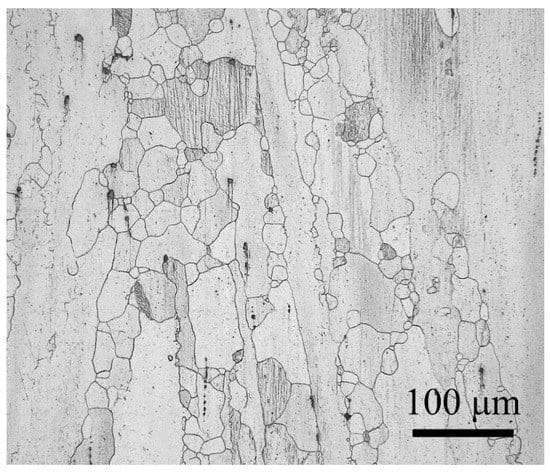
Figure 1.
Metallographic microstructure of original AZ31 magnesium alloy rod.

Figure 2.
(a) Electron back scattering diffraction (EBSD) map and (b) (0002), (c) (110), (d) (11 0) pole figures of original AZ31 magnesium alloy rod.
3.2. Microstructure of AZ31 Magnesium Alloy Sheets Prepared by Low-Speed Extrusion
Figure 3 presents the positions for microstructure observation of the extruded sheet prepared by low-speed extrusion. Figure 4 presents the metallographic microstructure of the extruded sheets prepared by low-speed extrusion at different temperatures, where Figure 4a–c indicates the metallographic microstructure at position 1 suggested by Figure 3, and Figure 4d–f shows the metallographic microstructure at position 2. As indicated by Figure 4a–c, at position 1 of the extruded sheets, dynamic recrystallization occurred at the grain boundary and a ring-shaped fine grain microstructure formed. This phenomenon became more obvious for the sheets extruded at 350 °C and 400 °C. The deformation amount of the magnesium alloy was minor at position 1, and the stored deformation energy was also insufficient such that partial original coarse grains and elongated deformed microstructure were still preserved. Because of the high degree of plastic deformation and dramatic dynamic recrystallization, the microstructure of the extruded sheets prepared by low-speed extrusion under different temperatures became more homogeneous at position 2, and the average grain size was reduced. Fine equiaxed grains formed via dynamic recrystallization in the extruded sheets prepared by low-speed extrusion. During the dynamic recrystallization process, the average size (d) of recrystallized grains has the following relationship with the Zener–Hollomon parameter (Z): lnd = A − BlnZ. Further, Z, which represents the temperature-modified strain rate, is Z = εexp (Q/RT) [12]. Here, A and B are constants, ε denotes the strain rate during extrusion, Q denotes the deformation activation energy, T denotes the extrusion temperature, and R is the gas constant. It is concluded from the above formula that the size for dynamic recrystallized grains is inversely proportional to lnZ and that Z is also inversely proportional to temperature T. Therefore, the average size of grains formed by dynamic recrystallization increased as the extrusion temperature rose. As indicated by Figure 4d–f, with increasing extrusion temperature, the grain size of the extruded sheets prepared by low-speed extrusion at position 2 increased. The average grain sizes of the AZ31 magnesium alloy sheets extruded at 350 °C, 400 °C, and 450 °C were 2.7 ± 0.2 μm, 4.1 ± 0.3 μm, and 6.0 ± 0.3 μm, respectively. Thus, the influence of low-speed extrusion on the grain refinement of AZ31 Mg alloy sheets was dramatic. Furthermore, the grain size of ~2.7 μm for the extruded sheets produced by low-speed extrusion at 350 °C was substantially lower than the average grain size of extruded AZ31 magnesium alloys reported in the literature [13,14,15]. Li et al. [13] suggested that the average grain size of AZ31 alloy sheets prepared by continuous variable cross-section direct extrusion at 350 °C, an extrusion speed of 1 mm/s, and an extrusion ratio of 44.4 was 6.18 μm. Xu et al. [14] prepared AZ31 magnesium alloys by forward extrusion having an extrusion ratio of 33:1 and an extrusion temperature of 400 °C, and the average grain size was 9.3 μm. Pan et al. [15] prepared AZ31 magnesium alloys by conventional direct extrusion with an extrusion ratio of 31.52 at 400 °C, and the microstructure was very inhomogenous, which consisted of 6–8 μm fine grains and 13–16 μm irregular elongated grains.
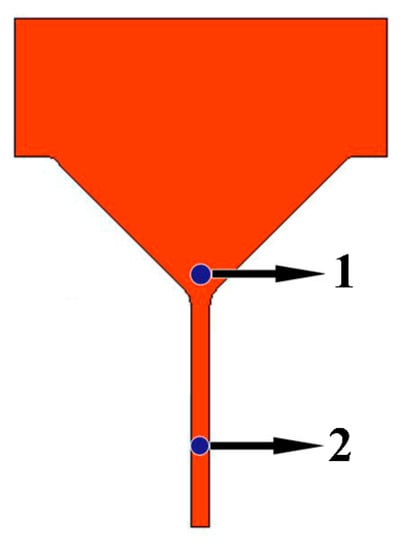
Figure 3.
Positions for microstructure observation of the extruded sheet prepared by low-speed extrusion.
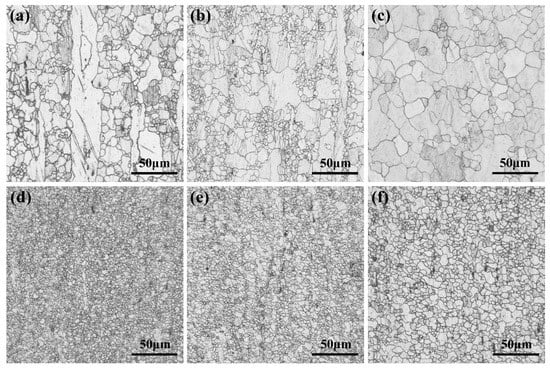
Figure 4.
Metallographic microstructure of the extruded sheets prepared by low-speed extrusion at different temperatures: (a,d) 350 °C; (b,e) 400 °C; (c,f) 450 °C.
Figure 5 presents the EBSD maps and (0002), (110), and (120) pole figures at position 2 of the extruded sheets produced by low-speed extrusion at different temperatures. The EBSD maps in Figure 5 also show that the extruded sheets prepared by low-speed extrusion had a uniform microstructure, and the grain size increased as the extrusion speed rose; the results are similar to those in Figure 4. As indicated by the (0002) pole figure in Figure 5, all the extruded sheets produced by low-speed extrusion exhibited a typical (0002) basal texture, and the (0002) basal planes in the majority of grains were parallel to the extrusion direction. Further, with increasing extrusion temperature, the max basal texture intensity of the extruded sheets decreased gradually. The max basal texture intensity of the extruded sheets produced by extrusion at 350 °C, 400 °C, and 450 °C was 18.03, 16.01, and 15.82, respectively. This was because as the extrusion temperature rose, the critical resolved shear stress (CRSS) of the non-basal slips, such as prismatic slip and pyramidal slip, of the magnesium alloys decreased. For instance, for magnesium alloys, the CRSS of the prismatic slip was close to that of the basal slip, when the deformation temperature was above 300 °C [16,17]. Hence, the initiation of more non-basal slips, e.g., prismatic slip and pyramidal slip, will lead to the increase of grains having a non-basal orientation, which results in the relative decrease of basal texture strength [18,19]. In addition, as indicated by the (110) and (120) pole figures in Figure 5, there was no preferred orientation for the (110) and (120) prismatic planes in the extruded sheets prepared by low-speed extrusion.
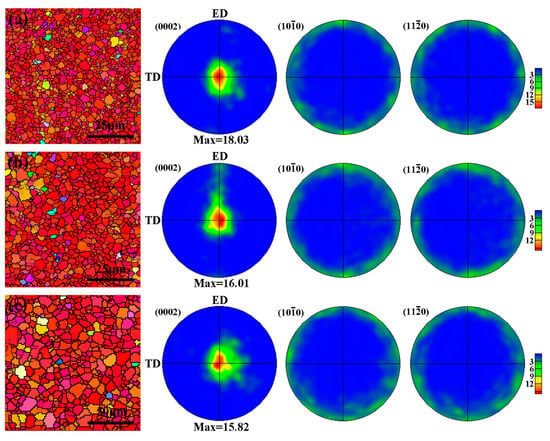
Figure 5.
EBSD maps and (0002), (110), (1 20) pole figures of the extruded sheets prepared by low-speed extrusion at different temperatures: (a) 350 °C; (b) 400 °C; (c) 450 °C.
3.3. Mechanical Properties of AZ31 Magnesium Alloy Sheets Prepared by Low-Speed Extrusion
Figure 6 indicates the true tensile stress–strain curves of AZ31 magnesium alloy sheets fabricated by low-speed extrusion at different temperatures. The true stress–strain curves were determined along the extrusion direction under room temperature. Table 1 presents their mechanical properties, i.e., the yield strength, tensile strength, and elongation. As indicated in Figure 6, as the extrusion temperature decreased, the tensile stress–strain curve of the extruded sheets increased gradually, and the yield strength and tensile strength also increased gradually, but the elongation changed slightly. As indicated by Table 1, the extruded sheet obtained by low-speed extrusion at 350 °C exhibited the highest overall mechanical properties. Its yield strength, tensile strength, and elongation were ~226 MPa, ~353 MPa, and ~16.7%, respectively, which are much larger than those of the AZ31 alloy sheets prepared using the traditional extrusion or rolling processes reported in the literature [20,21,22]. For example, Yang et al. [20] prepared AZ31 alloy sheets by the forward extrusion process at 430 °C having an extrusion ratio of 10:1 and an extrusion rate of 20 mm/s; the extruded magnesium alloy sheet had a yield strength, tensile strength, and elongation of ~156 MPa, ~327 MPa, and ~19.7%, respectively. Li et al. [21] prepared AZ31 alloy sheets at the extrusion temperature of 380 °C, and the yield strength, tensile strength, and elongation of the sheets were 107 MPa, 230 MPa, and 19.3%, respectively. Zhou et al. [22] prepared AZ31 alloy sheets using the traditional rolling process with different rolling speed, and the prepared sheets rolled at a rolling speed of 0.1 mm/s exhibited a yield strength, tensile strength, and elongation of 174 MPa, 279 MPa, and 18.9%, respectively. In addition, as the extrusion temperature rose, the mechanical properties of the extruded sheets prepared by low-speed extrusion deteriorated. The yield strength, tensile strength, and elongation of the sheet extruded at 400 °C were ~200 MPa, ~332 MPa, and ~16.4%, respectively, whereas at the extrusion temperature of 450 °C, they were ~177 MPa, ~320 MPa, and ~17.3%, respectively.
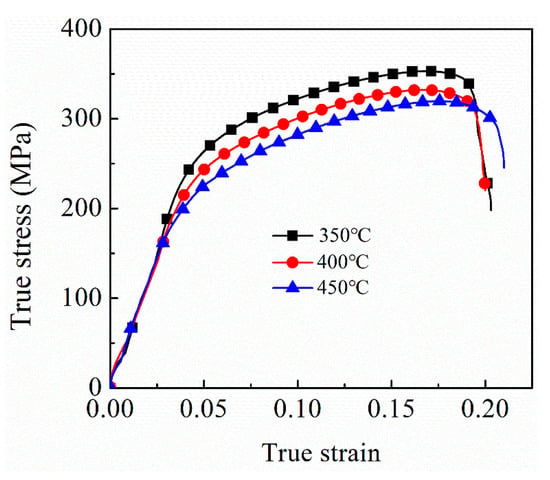
Figure 6.
True tensile stress–strain curves of the extruded sheets fabricated by low-speed extrusion.

Table 1.
Mechanical properties of the extruded sheets fabricated by low-speed extrusion.
As indicated by the above results of microstructure analyses, a higher extrusion temperature led to a larger grain size of the extruded sheets prepared by low-speed extrusion, while the grain size had a profound effect on the mechanical properties of metallic materials. Because the grain boundary will hinder the movement of dislocations, the stress concentration generated by the piling up of dislocations in large grains is more likely to induce the occurrence of plastic deformation in adjacent grains compared to that in fine grains. The stress concentration in fine grains is less severe, so a large external stress is required to activate the deformation in adjacent grains [23,24]. Hence, the extruded sheets prepared at 350 °C, having a finer grain size, exhibited a higher strength. In addition, the basal texture strength also has an impact on the yield strength of magnesium alloys. Weak basal texture strength favors the initiation of basal slips during plastic deformation [25], resulting in a low yield strength. This is one of the reasons why the yield strength of the produced sheets decreased with increasing extrusion temperature.
4. Conclusions
This work investigated the effect of the extrusion temperature on the microstructure evolution and mechanical properties of AZ31 magnesium alloy sheets prepared by low-speed extrusion. Results indicated that low-speed extrusion led to the effective refinement of microstructure and enhancement of the mechanical properties of the AZ31 magnesium alloys. When the extrusion temperatures were 350 °C, 400 °C, and 450 °C, the average grain sizes of the extruded sheets were ~2.7 μm, ~4.1 μm, and ~6.0 μm, respectively. A strong (0002) basal texture was observed within the prepared sheets, and the max basal texture intensity was reduced as the extrusion temperature rose. Further, the mechanical properties of the sheets prepared by low-speed extrusion deteriorated as the extrusion temperature rose. When the extrusion temperature was 350 °C, the highest overall mechanical properties were observed, where the yield strength, tensile strength, and elongation were ~226 MPa, ~353 MPa, and ~16.7%, respectively.
Author Contributions
Conceptualization, W.Z., H.Z.; investigation, W.Z., L.W.; formal analysis, J.F., X.L.; writing—original draft, W.Z., H.Z.; validation, L.Z., S.C.; writing—review and editing H.J.R., S.Z. All authors have read and agreed to the published version of the manuscript.
Funding
The authors acknowledge the financial support by National Natural Science Foundation of China (U1810122, U1710118, 51504162 and 51704209), Key Research and Development Program of Shanxi Province (201903D421076 and 201803D421086), Talent Training Program for Shandong Province Higher Educational Youth Innovative Teams (2019), Innovative Talents of Higher Education Institutions of Shanxi (2018), Top Discipline in Materials Science of Shandong Province (2019), and Major Scientific and Technological Innovation Project in Shandong Province (2019JZZY010325).
Conflicts of Interest
The authors declare no conflict of interest.
References
- Jin, Z.Z.; Cheng, X.M.; Zha, M.; Rong, J.; Zhang, H.; Wang, J.G.; Wang, C.; Li, Z.G.; Wang, H.Y. Effects of Mg17Al12 second phase particles on twinning-induced recrystallization behavior in Mg-Al-Zn alloys during gradient hot rolling. J. Mater. Sci. Technol. 2019, 35, 2017–2026. [Google Scholar] [CrossRef]
- Mordike, B.L.; Ebert, T. Magnesium: Properties—Applications—Potential. Mater. Sci. Eng. A 2001, 302, 37–45. [Google Scholar] [CrossRef]
- Zhang, H.; Huang, G.S.; Fan, J.F.; Roven, H.J.; Xu, B.S.; Dong, H.B. Deep drawability and drawing behaviour of AZ31 alloy sheets with different initial texture. J. Alloys Compd. 2014, 615, 302–310. [Google Scholar] [CrossRef]
- Zha, M.; Zhang, H.M.; Yu, Z.Y.; Zhang, X.H.; Meng, X.T.; Wang, H.Y.; Jiang, Q.C. Bimodal microstructure—A feasible strategy for high-strength and ductile metallic materials. J. Mater. Sci. Technol. 2018, 34, 257–264. [Google Scholar] [CrossRef]
- Zeng, Z.R.; Stanford, N.; Davies, C.H.J.; Nie, J.F.; Birbilis, N. Magnesium extrusion alloys: A review of developments and prospects. Int. Mater. Rev. 2019, 64, 27–62. [Google Scholar] [CrossRef]
- Aghion, E.; Bronfin, B. Magnesium alloys development towards the 21st century. Mater. Sci. Forum 2000, 350, 19–30. [Google Scholar] [CrossRef]
- Han, T.Z.; Huang, G.S.; Ma, L.F.; Wang, G.G.; Wang, L.F.; Pan, F.S. Evolution of microstructure and mechanical properties of AZ31 Mg alloy sheets processed by accumulated extrusion bonding with different relative orientation. J. Alloys Compd. 2019, 784, 584–591. [Google Scholar] [CrossRef]
- Yang, Q.S.; Jing, B.; Song, B.; Yu, D.L.; Chai, S.S.; Zhang, J.Y.; Pan, F.S. Mechanical behavior and microstructure evolution for extruded AZ31 sheet under side direction strain. Prog. Nat. Sci. Mater. Int. 2020, 30, 270–277. [Google Scholar] [CrossRef]
- Jiang, M.G.; Xu, C.; Yan, H.; Fan, G.H.; Nakata, T.; Lao, C.S.; Chen, R.S.; Kamado, S.; Han, E.H.; Lu, B.H. Unveiling the formation of basal texture variations based on twinning and dynamic recrystallization in AZ31 magnesium alloy during extrusion. Acta Mater. 2018, 157, 53–71. [Google Scholar] [CrossRef]
- Zhang, Y.; Chen, X.Y.; Liu, Y.L. Microstructure and mechanical properties of as-extruded Mg-Sn-Zn-Ca alloy with different extrusion ratios. Trans. Nonferrous Met. Soc. China 2018, 28, 2190–2198. [Google Scholar] [CrossRef]
- Zhang, X.B.; Yuan, G.Y.; Niu, J.L.; Fu, P.H.; Ding, W.J. Microstructure, mechanical properties, biocorrosion behavior, and cytotoxicity of as-extruded Mg-Nd-Zn-Zr alloy with different extrusion ratios. J. Mech. Behav. Biomed. Mater. 2012, 9, 153–162. [Google Scholar] [CrossRef] [PubMed]
- Ammouri, A.H.; Kridli, G.; Ayoub, G.; Hamade, R.F. Relating grain size to the Zener-Hollomon parameter for twin-roll-cast AZ31B alloy refined by friction stir processing. J. Mater. Process. Technol. 2015, 222, 301–306. [Google Scholar] [CrossRef]
- Li, X.B.; Li, F.; Li, X.W. Microstructural characteristics of AZ31 magnesium alloy processed by continuous variable cross-section direct extrusion (CVCDE). Part 1: Texture evolution. JOM 2018, 70, 2327–2331. [Google Scholar] [CrossRef]
- Xu, J.; Song, J.F.; Jiang, B.; He, J.J.; Wang, Q.H.; Liu, B.; Huang, G.S.; Pan, F.S. Effect of effective strain gradient on texture and mechanical properties of Mg-3Al-1Zn alloy sheets produced by asymmetric extrusion. Mater. Sci. Eng. A 2017, 706, 172–180. [Google Scholar] [CrossRef]
- Pan, F.S.; Wang, Q.H.; Jiang, B.; He, J.J.; Chai, Y.F.; Xu, J. An effective approach called the composite extrusion to improve the mechanical properties of AZ31 magnesium alloy sheets. Mater. Sci. Eng. A 2016, 655, 339–345. [Google Scholar] [CrossRef]
- Yin, D.D.; Wang, W.D.; Boehlert, C.J.; Chen, Z.; Li, H.; Mishra, R.K.; Chakkedath, A. In-Situ Study of the Tensile Deformation and Fracture Modes in Peak-Aged Cast Mg-11Y-5Gd-2Zn-0.5Zr. Metall. Mater. Trans. A 2016, 47, 6438–6452. [Google Scholar] [CrossRef]
- Barnett, M.; Keshavarz, Z.; Beer, A.; Atwell, D. Influence of grain size on the compressive deformation of wrought Mg-3Al-1Zn. Acta Mater. 2004, 52, 5093–5103. [Google Scholar] [CrossRef]
- Agnew, S.R.; Duygulu, O. Plastic anisotropy and the role of non-basal slip in magnesium alloy AZ31B. Int. J. Plast. 2005, 21, 1161–1193. [Google Scholar] [CrossRef]
- Wu, S.K.; Chou, T.S.; Wang, J.Y. The deformation textures in an AZ31B magnesium alloy. Mater. Sci. Forum 2003, 419–422, 527–532. [Google Scholar] [CrossRef]
- Yang, Q.S.; Jiang, B.; Yu, Z.J.; Dai, Q.W.; Luo, S.Q. Effect of extrusion strain path on microstructure and properties of AZ31 magnesium alloy sheet. Acta Metall. Sin. Engl. Lett. 2015, 28, 1257–1263. [Google Scholar] [CrossRef]
- Li, R.H.; Pan, F.S.; Jiang, B.; Dong, H.W.; Yang, Q.S. Effect of Li addition on the mechanical behavior and texture of the as-extruded AZ31 magnesium alloy. Mater. Sci. Eng. A 2013, 562, 33–38. [Google Scholar] [CrossRef]
- Zhou, T.; Yang, Z.; Hu, D.; Feng, T.; Yang, M.B.; Zhai, X.B. Effect of the final rolling speeds on the stretch formability of AZ31 alloy sheet rolled at a high temperature. J. Alloys Compd. 2015, 650, 436–443. [Google Scholar] [CrossRef]
- Apps, P.J.; Karimzadeh, H.; King, J.F.; Lorimer, G.W. Precipitation reactions in Magnesium-rare earth alloys containing Yttrium, Gadolinium or Dysprosium. Scr. Mater. 2003, 48, 1023–1028. [Google Scholar] [CrossRef]
- Dudamell, N.V.; Ulaci, L.; Gálvez, F.; Yi, S.; Bohlen, J.; Letzig, D.; Hurtado, L.; Pérez-Prado, M.T. Twinning and grain subdivision during dynamic deformation of a Mg AZ31 sheet alloy at room temperature. Acta Mater. 2011, 59, 6949–6962. [Google Scholar] [CrossRef]
- Huang, X.S.; Suzuki, K.; Saito, N. Textures and stretch formability of Mg-6Al-1Zn magnesium alloy sheets rolled at high temperatures up to 793 K. Scr. Mater. 2009, 60, 651–654. [Google Scholar] [CrossRef]
© 2020 by the authors. Licensee MDPI, Basel, Switzerland. This article is an open access article distributed under the terms and conditions of the Creative Commons Attribution (CC BY) license (http://creativecommons.org/licenses/by/4.0/).